
The Mill is a painting by Dutch baroque artist Rembrandt Harmenszoon van Rijn. It is in the permanent collection of the National Gallery of Art in Washington DC. For a long time, the attribution to Rembrandt was regarded as doubtful; it has been restored in recent years, although it is not universally accepted. The painting was formerly in the Orleans Collection. It was once owned by Peter Arrell Brown Widener.

Dirck Jansz Pesser was a Dutch brewer from Rotterdam, best known today for his portrait by Rembrandt. He was an important member of the Rotterdam Remonstrant community in the early 17th century.

Old Man with a Gold Chain is a portrait by Rembrandt, painted in oils on canvas around 1631. It is now in the Art Institute of Chicago.
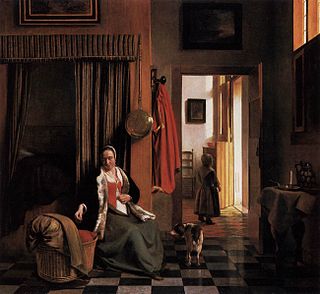
Woman lacing her bodice beside a cradle is an oil-on-canvas painting by the Dutch painter Pieter de Hooch, created c. 1660–1663. It is part of the collection of the Gemäldegalerie, Berlin.

Portrait of Jan Six is a 1654 oil-on-canvas painting by the Dutch painter Rembrandt van Rijn. Having been handed down many generations, via the direct descendants of the portrait's subject, Jan Six, the work remains in the Six Collection in Amsterdam.
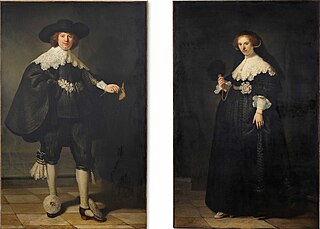
The pendant portraits of Maerten Soolmans and Oopjen Coppit are a pair of full-length wedding portraits by Rembrandt. They were painted on the occasion of the marriage of Maerten Soolmans and Oopjen Coppit in 1634. Formerly owned by the Rothschild family, they became jointly owned by the Louvre Museum and the Rijksmuseum in 2015 after both museums managed to contribute half of the purchase price of €160 million, a record for works by Rembrandt.

Portrait of Catharina Hooghsaet (1607–1685) is a 1657 painting by the Dutch Golden Age painter Rembrandt.

Portrait of Maria Trip (c.1639) is an oil painting on panel by the Dutch painter Rembrandt. It is an example of Dutch Golden Age painting and is now in the collection of the Rijksmuseum.

Saint Matthew and the Angel is an oil painting on canvas by the Dutch master Rembrandt. It is an example of Dutch Golden Age painting and is now in the collection of the Louvre.

The Kitchen Maid (1651) is an oil-on-canvas painting by the Dutch painter Rembrandt. It is an example of Dutch Golden Age painting and is now in the collection of the Nationalmuseum in Stockholm, Sweden.

The Rape of Ganymede is an oil painting of 1635 by the Dutch Golden Age painter Rembrandt, depicting the myth of Ganymede. It is in the collection of the Gemäldegalerie Alte Meister in Dresden.

The Stone Bridge is a 1637 landscape painting by the Dutch Golden Age painter Rembrandt in the collection of the Rijksmuseum.
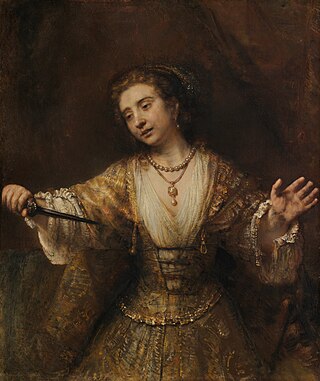
Lucretia is a 1664 history painting of Roman noblewoman Lucretia, historically attributed to the Dutch Golden Age painter Rembrandt in the collection of the National Gallery of Art. In 2015, Ernst van de Wetering of the Rembrandt Research Project said that "the formal properties and execution of [this] painting, I am convinced, exclude the possibility that it could be an autograph work by Rembrandt", and that the painting recalls Aert de Gelder. The painting is not included in the project's 2015 Rembrandt corpus.
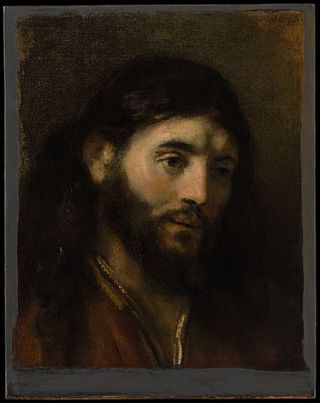
Head of Christ is a 1650s painting by Rembrandt's workshop. It shows Christ with a beard and long dark hair. It is in the collection of the Metropolitan Museum of Art.

Portrait of a Man is a c. 1657 portrait painting painted by Rembrandt. It is an oil on canvas and is in the collection of the Metropolitan Museum of Art.

Portrait of a Young Woman with a Fan is a 1633 portrait painting by Rembrandt. It shows a woman holding a fan, pendant to Portrait of a Man Rising from His Chair. It is in the collection of the Metropolitan Museum of Art.

Portrait of Petronella Buys (1610–1670) is a 1635 portrait painting painted by Rembrandt. It shows a young woman with a very large and impressive millstone collar. It is in a private collection.

The Standard Bearer is a three-quarter-length self-portrait by Rembrandt formerly in the Paris collection of Elie de Rothschild, and purchased by the Rijksmuseum for 175 million euros with assistance from the Dutch state and Vereniging Rembrandt in 2021. It was painted on the occasion of the artist's move from Leiden to Amsterdam and is seen as an important early work that "shows Rembrandt's ambition to paint a group portrait for the Amsterdam militia, at the time the most valued commission a painter could be awarded."

Landscape with Arched Bridge is a circa 1637-1638 landscape painting by the Dutch Golden Age painter Rembrandt in the collection of the Gemäldegalerie, Berlin.
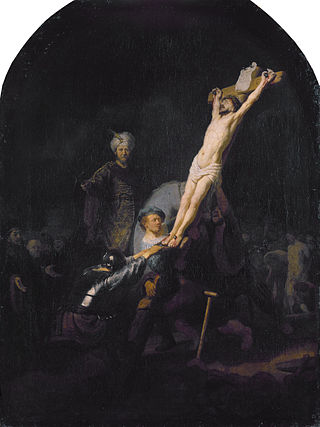
Raising of the Cross is a 1633 painting by the Dutch Golden Age painter Rembrandt in the collection of the Alte Pinakothek. It was painted as part of a "passion" series commissioned in 1633 by Frederick Henry, Prince of Orange. Together with its pendant, The Descent from the Cross, it is one of the rare paintings by Rembrandt with a continuous provenance from the date of completion to today.
























